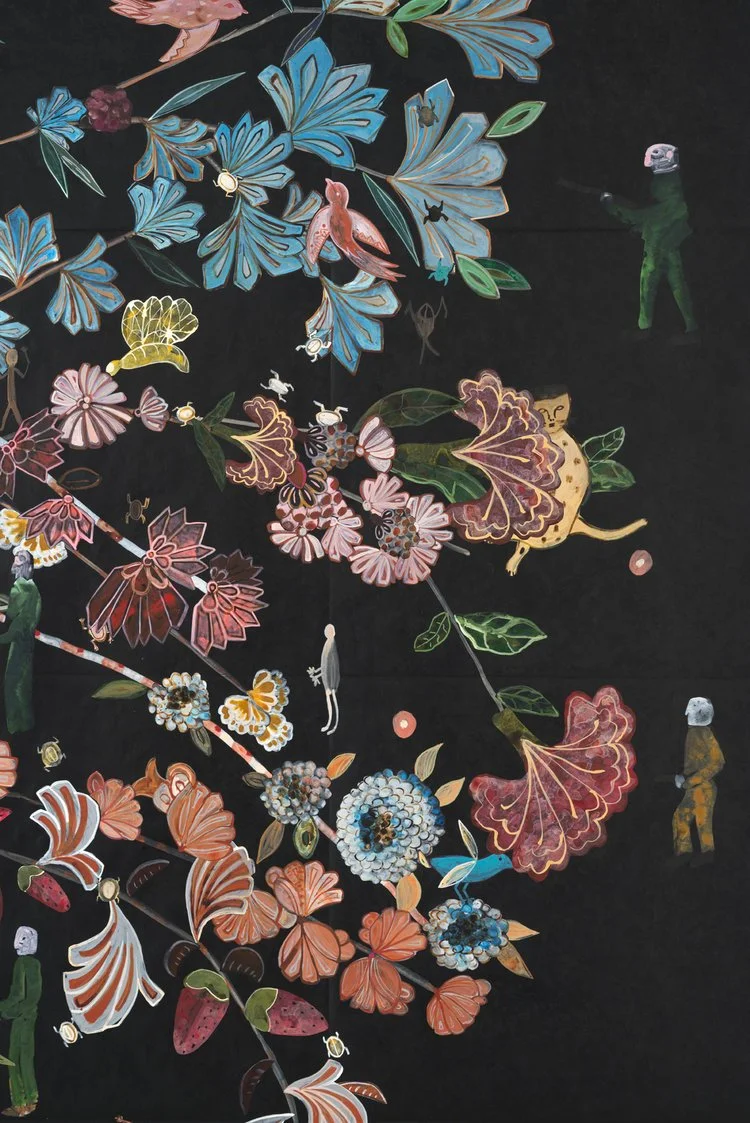Nancy Friedemann-Sánchez Explores Colonialism’s Invasion and Evolution
Spanish Colonial culture is at the core of Nancy Friedemann-Sanchez’ practice. She lays
bare a centuries-old history that is neither diluted nor forgotten but is remembered in specific
objects. One is easily entranced by how seamlessly this historical tension is as much a part
of the scenery as is its captured beauty.
The history of the Spaniards influence on Central American culture is now fully ingrained and
Friedemann-Sanchez neither hides nor exaggerates this influence. The large-scale of her
paintings appear as a historical reckoning. Their beauty is undeniable, but closer inspection
reveals these influences have infiltrated and altered the original landscape. The artist deftly
considers these changes with a subtle critique.
As a series, the paintings contain several similarities. The flora and fauna might change and
you soon notice tiny figures with guns throughout these works. These armed men and the
drones that buzz about the paintings allude to the Colombian Conflict, which has been
ongoing since 1964. Subtle, discreet, but very present everywhere, they are a portrayal of a
history that superficially appears as a naturally occurring effect. But the artists’ small
depictions present a very steep infiltration occurring over centuries.
Friedemann_Dream_Map_and_Cornucopia_India-Ink-on-Tyvek.jpg
Too, hollow serpents wend their way around the central images of plants. The plants are
exactly the place for the serpents to inhabit. When not directly within the flora, they are on
the borders as well, waiting to strike. For the viewer to see them on the periphery speaks to
the invasive forces of chaos and militarization. This historical contextualization Friedemann-
Sánchez presents to us is an overwhelming presence of forces that exemplify the trauma of
colonization that extended all the way north to Mexico with the Fall of Tenochtitlan around
1521, where the Spanish seized access to the Pacific Ocean, creating new routes to
Asia. It’s exhausting and as a naturally occurring environment, leaving pause to question
what the landscape might otherwise look like if an invasion of centuries past had never
occurred.
Friedemann-Sánchez maintains a flattened, tonal perspective on her paintings to offer a
resolute and unadorned version of this history lesson. The colors don’t pop off the blacktoned
Tyvek panels, they’re anchored as collage pieces. You can see the points up close
where these panels create a dimensional ability to possibly come undone and float away.
Changes aren’t permanent and even the invaders can reconsider is the message I am
receiving. The artist herself says, Tyvek is not paper, its use is “multi-determined.” Speaking
with the artist via email, she notes the resilience of Tyvek’s archival properties. Similar to “the
resilience of someone who migrates and moves around. The material is industrial and
creates a bridge to the past; it makes use of contemporary technologies.” The colonists who
migrated had their own cultural adapting. It was necessary to change from their accustomed
Arabic and European pigments to egg and other local materials to create botanical
illustrations. “In doing so, they transformed a tradition.”
Cornucopia No3 India Ink on Tyvek
These are paintings of a scale that is much closer to a political wheatpaste; where nothing is
written, but these images of beauty and brutality say far more than any pithy catchphrase.
Nor is it necessary to pontificate upon its rationality or even its existence. Freidemann-
Sanchez takes us right into the middle of the scenario; not what once was, not what might it
have been, but a direct descent into the gullet of present-day.
Viewing this work multiple times is necessary; each visit is a story, a parable, tales of
invasion and evolution. The artists’ portrayal of the history of colonization and its violence is
alive not only in Colombia but in the United States as well, where violence is a state in which
we are far too comfortable. Friedemann-Sánchez presents an understanding that Spanish
Colonial Painting is “a patriarchal and ideological tool of subjugation” and everything that is
stolen has been stolen before. If history has taught us anything, it’s that civilization is mostly
predicated upon the con of changing and protecting history to suit one’s comfort.
Friedemann-Sánchez shows us very directly and very specifically, that every garden has its
walls.
Detail: Cornucopia No3 India Ink on Tyvek
Detail: Cornucopia No3 India Ink on Tyvek
Chola, India Ink on Tyvek, Indigenous Mask, Spanish Comb
Cornucopia runs November 2 through December 29, 2018
The Drawing Room at Weinberger Fine Art
1903 Wyandotte Street, Kansas City, MO. 6 4108






